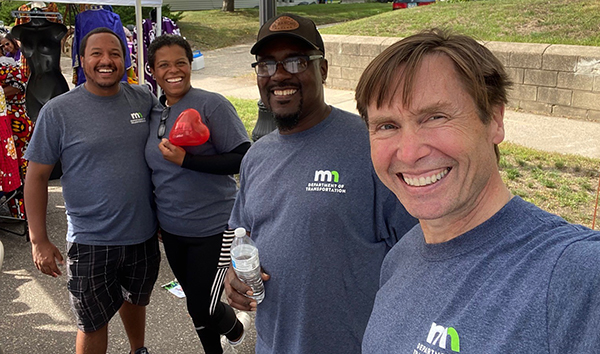 |
|

|
 |
TABLE of CONTENTS
|
Backing incidents reduced by 20% during 2022 Summer Safety Campaign |
By J.P. Gillach and Rod Starkey
MnDOT’s 2022 Summer Safety Campaign, which focused on reducing backing incidents, has come to a close. While the agency did not achieve its goal of reducing backing incidents by 50% from June through August as compared to last year, MnDOT’s 5,100 employees did make a marked improvement of a 20% decrease.
“Although we did not achieve our target as an agency, many offices, districts and truck stations did achieve this goal, or surpass it, and should be proud of that achievement,” said Stephanie Raley, MnDOT safety culture director. “The most important action we can take is to remain actively focused on safety and committed to continuous improvement. By talking about safety, sharing ideas and learning from our mistakes, we’ll continue to reduce incidents, injuries, and improve safety for everyone.”
Districts became inspired to reduce backing incidents. Two ideas that caught on were implemented in Metro District and District 8.
One idea, brought up by Metro Program Delivery and first implemented in Metro District’s Oakdale Construction Office, uses traffic cones placed at the front and back of vehicles every time the vehicle is parked. The process ensures that drivers walk a full circle around the vehicle to become aware of people, obstructions, vehicles or other obstacles that may be present – performing a “circle of safety” in accordance with MnDOT’s motor vehicle backing safety directive.
“Many offices in Metro have chosen to adopt the practice,” said Julie Libonate, Metro District Safety Supervisor. “Implementation is going well, and we expect we’ll see more of this in the future. This is something that’s been proven to work well in the private sector, and it just makes sense to implement it here, too.”
Another idea, from District 8, was to put up wall signs that encourage a 360-degree circle of safety.
“We put circle of safety signs in all district buildings, next to where vehicles and equipment are parked, to remind employees to do a 360-degree walkaround before they get into the vehicle or equipment,” said Mark Pierskalla, District 8 Safety Administrator. “It’s a friendly reminder to check for obstacles and people in the immediate area before moving the vehicle and equipment.”
For more information about Vehicle and Equipment Backing, along with additional safety resources, click the My Safety icon on the desktop of your agency computer, scroll to “Safety directives,” and then click on “Motor vehicle backing directive (PDF).”
MnDOT’s next Safety Campaign will be Reducing Slips, Trips, and Falls, which remain the most common contributing factors for injuries reported at MnDOT. The campaign starts in November and runs through January. Watch for more information and contact your local safety administrator as we get closer to the winter campaign kick-off.

For more tips and guidance, review MnDOT’s Motor Vehicle and Equipment Backing Safety Directive. This information, and all safety directives, can be found on MnDOT’s online Workplace Safety Planner by clicking the My Safety icon on your computer desktop.
|
|
 |
|

|
 |
TABLE of CONTENTS
|
New Employee Action Plan now available |
By Cori Calhoun, Assistant Commissioner (Acting), Workforce & Agency Services Division

|
As stated in the Note Mailer that went out yesterday, I am pleased to announce the launch of MnDOT’s new Employee Engagement Action Plan! We will use this plan to guide and communicate our engagement activities over the next several years.
Directly informed by your input on MMB’s Engagement and Inclusion Survey, this plan identifies key strategies to help our agency improve in three focus areas: Communication and Development, Workplace Inclusion/Respectful Workplace, and Overall Satisfaction.
This action plan is intended to help create a work environment where employees can thrive, where trust is high, and relationships are strong.
Research shows that a positive employee experience can result in higher levels of retention, a sense of belonging, feeling valued, engagement, motivation, increased productivity, and can serve as an indicator of organization success. While we have a variety of engagement resources available, now is the time to expand our tools, explore new approaches, and emphasize that this is a high priority.
We have asked our managers to focus on the first strategy listed in the action plan: Complete Engagement Interviews or Individual Development Plans (IDPs) with employees. Some offices and districts are already advancing this strategy as a best practice through their current business plan. You should expect to hear soon from your leadership on continuing or beginning engagement activities.
Visit the new Employee Engagement iHUB page for additional details and to provide your ideas through an online form. We will update the site as new resources are available and post periodic updates in MnDOT Newsline as we make progress.
Your contributions and hard work are the reason why MnDOT can provide outstanding service to the people of Minnesota. Thank you again for the work you do to support transportation in Minnesota! |
 |
|

|
 |
TABLE of CONTENTS
 |
Staffing updates |

Lynn Clarkowski. |
Clarkowski is new assistant division director in Engineering Services Division
Lynn Clarkowski has stepped into a new role as the assistant division director in the Engineering Services Division, effective September 14. She will be serving in a work-out-of-class mobility role, filling the vacancy previously held by Michel Beer, who is serving in a WOOC as the assistant commissioner in the Engineering Services Division.
Clarkowski previously worked as the Metro District operations and maintenance director, leading maintenance, bridge, traffic and RTMC offices. She has also served as the Metro District program delivery director and as a member of Metro’s management team since mid-2018, and managed MnDOT’s Office of Environmental Stewardship, among other positions.

Nicki Bartelt. |
Bartelt is new office director for Office of Environmental Stewardship
The Office of Environmental Stewardship has a new office director: Nicki Bartelt, who will be serving in a work-out-of-class mobility role filling the vacancy previously held by Marni Karnowski (who is serving in a WOOC as the assistant division director in the Workforce and Agency Services Division).
Bartelt graduated from Michigan State University with a BSCE in 2002 and MS ENE (Environmental) in 2004, with an emphasis in water resources. She worked for the Michigan Department of Transportation before coming to the Minnesota Department of Transportation in 2006.
At MnDOT, she has worked in bridge hydraulics, project management, STEM outreach, environmental stewardship, and most recently held the bridge planning and hydraulics engineer position for the past three years. |
 |
|

|
 |
TABLE of CONTENTS
|
New Limited English Proficiency addendum reports now available |
|
By Alyssa Kruzel The Office of Transportation System Management has updated the district Limited English Proficiency addendum reports to correct an issue that was discovered for the projects requiring translation in the CHIP years. The Public Engagement iHUB webpage has been updated to link to the new district LEP addendum reports.
The District LEP addendums can be found on the Public Engagement iHUB site on the homepage, as well as under the “Plan” and “Reference” tabs. Please contact Brad Utecht and Kathryn Engelhardt for questions or concerns about the district EJ or LEP reports. |
 |
|

|
 |
TABLE of CONTENTS
|
NewsBank offers easy access to Minnesota news at your fingertips |
|
By Julie Swiler, Office of Research & Innovation
If you’re looking for the latest article about MnDOT or finding yourself hitting paywalls, the MnDOT Library is here to help.
MnDOT staff have access to Minnesota news sources through the library’s NewsBank subscription. Current and archival news stories are available from a total of 56 news outlets, including newspapers and some television and radio stations. Note that some articles are not posted immediately, and some news sources do not make all content available.
To access NewsBank, go to the MnDOT Library Newspapers Resource, and then search by keyword or news source. You also can create an email alert for a specific topic. Articles can be read online, downloaded, linked, printed or emailed. A web reader option enables users to listen to the story online.
If you can’t find what you are looking for, contact the MnDOT Library. |
 |
|

|
 |
TABLE of CONTENTS
|
Survey to help guide MnSHIP updates |
|
By Josh Pearson, MnSHIP Project Manager The Office of Transportation System Management is updating the 20-Year Minnesota State Highway Investment Plan and is seeking input from MnDOT staff. MnSHIP guides future capital investment decisions on the state highway system. The plan analyzes difficult and important trade-offs for how to invest in the state highway system and identifies priorities for investment.
MnDOT staff are invited and requested to complete a quick survey to understand the investment priorities from within MnDOT. The last page of the survey asks participants to identify their office/district so the project team can understand how perspectives may vary across the agency. The team is conducting a first round of public engagement and asking these same questions to transportation partners, stakeholders and the public. The team would like to analyze their responses compared to responses from internal staff when considering priorities for the draft investment direction.
Take a few minutes to complete the survey by October 7 to insure that your input is included.
For more about MnSHIP, watch a short introductory video or visit the Minnesota Go website for information about the 2017 plan and MnSHIP investment categories, or to try your hand at creating your own investment approach with the online highway budget tool.
For specific questions about the plan update, contact Josh Pearson, project manager, or Brad Utecht, Project Director. |
 |
|

|
 |
TABLE of CONTENTS
|
On the Job: Abdullahi Abdulle works toward transportation equity |
By Kiran Sjoberg and Doug Mack

Abdullahi Abdulle is MnDOT's transportation equity planning coordinator. Submitted photo
|
Since joining MnDOT in 2021, Abdullahi Abdulle has worked on a range of projects regarding transportation equity.
Tell us about your career path up to this point
It has not been a perfect straight line. I first had an interest in civil engineering, so I studied civil engineering for a few semesters before I changed my major and graduated with a degree in construction management. After briefly working in the construction industry, I realized a career in the public sector would be more meaningful and fulfilling. I went back to school for a master’s degree in urban planning at Minnesota State University, Mankato. During graduate school, I was fortunate to work in both regional and local government. After getting my degree, I worked for Minneapolis Public Works until I accepted my current role at MnDOT.
What is your role as transportation equity planning coordinator?
I help our agency and other transportation partners understand how our transportation system—including our services and decision-making processes—help or harm the lives of underserved and overburdened people in Minnesota. Part of my job is to coordinate transportation planning efforts to identify and implement key actions, policy changes, and new partnerships to make meaningful change and address the challenges faced by many underserved communities. Most of the work involves coordination with internal and external leaders, stakeholders, community-based organizations and community members to identify transportation challenges and work together to address them.
What is your favorite aspect of your work?
My favorite part of the job is being able to listen to our communities and have conversations with colleagues about the different ways we can change our approaches to transportation service delivery, including for Minnesota communities that have historically been underserved. I like being able to contribute to the work of making fair and just outcomes for our communities. It especially resonates with me as I reflect on my own transportation access challenges as a new immigrant without a vehicle or the ability to live in a multimodal and well-connected neighborhood. I relied on public transportation to make a living and learned quickly how much work needed to be done to make our transportation system accessible, efficient and affordable.
Do you work in a team? If so, what are the other roles on your team?
I work in the Policy Planning Unit of the Office of Transportation System Management with three other colleagues. The other roles of the team include regional development organizations coordinator, metropolitan planning organizations coordinator and a supervisor overseeing all of the unit’s work in statewide transportation planning.
What are the biggest challenges of your job?
One is that most people look at transportation equity as an add-on item to the work they already do and not essential piece of it. An equitable system is incomplete system and one that is not meeting people’s basic transportation needs. Another challenge is the perception that advancing transportation equity is the responsibility of one or few individuals and not our collective responsibility. Everyone in our agency, regardless of position or work assignment, has a role to advance transportation equity. We will need to work together to understand what each person’s role looks like by providing support and resources like transportation equity training, which is currently undergoing.
What does a typical workday look like for you?
It usually involves attending meetings, giving presentations about our transportation equity efforts to internal and external audiences, participating internal and external technical advisory panels, coordinating with different partners, transportation project research management, and reviewing and commenting on different MnDOT plans and documents to ensure transportation equity issues are addressed.
Can you give us an overview of how MnDOT defines transportation equity?
As part of the Statewide Multimodal Transportation Plan, MnDOT completed a two-year long process to develop a shared definition, which was developed with significant consultation, collaboration and intentional engagement with agency leadership, employees and community partners.
Two of the key elements are an acknowledgment of the fact that the transportation system and agency decisions have underserved, excluded, harmed and overburdened some communities, and a commitment to creating an equitable transportation system. The text reads, in part, “Transportation equity means the benefits and burdens of transportation systems, services and spending are fair and just, which historically has not been the case. Transportation equity requires ensuring underserved communities, especially Black, Indigenous and People of Color, share in the power of decision making.” The full definition, and additional background information, is available for anyone to read as part of the SMTP.
Do you or a co-worker have an interesting job to share with readers? Send us your ideas, and we’ll contact you for more information.
Recent employee profiles:
|
 |
|

|
 |
TABLE of CONTENTS
|
Hwy 61 project is finalist for national award |
By Pippi Mayfield (District 1) and Doug Mack

Pedestrians cross Hwy 61 at a new crosswalk in Grand Marais. Photo from District 1 staff
|
The recent Hwy 61 project, in District 1, is one of 12 finalists for America’s Transportation Awards. The annual competition, sponsored by AASHTO, AAA and the U.S. Chamber of Commerce, has both a Grand Prize, selected by a jury of transportation industry experts, and a People’s Choice Award, determined by a public vote via the awards program website. Members of the public—including MnDOT employees!—can vote up to one time per day through October 21.
Both awards come with a $10,000 cash prize to be donated to a charity or scholarship of the winning DOT's choosing. If the Hwy 61 project wins, MnDOT plans to use the funds for the Roberta Dwyer Scholarship Fund. Roberta was a well-known project manager in D1 for more than 30 years and worked on many projects, including the Twin Ports Interchange project. The scholarship in her name is for women interested in entering the engineering field.
AASHTO will announce the winners at its annual meeting in Orlando next month.
The Hwy 61 project focused on improving pedestrian mobility and safety along the North Shore of Lake Superior. This work, which totaled $19.2 million, included narrowing the roadway, building better biking and pedestrian facilities along each side of the roadway and creating an environment where highway traffic would slow down so crossing the roadway would be safer. It also involved innovative land use, creating an attractive roadside environment that includes places to gather and rest, improved green space, and new lighting that improved visibility and safety for pedestrians and bikers while preserving the dark sky environment of the North Shore. |
 |
|

|
|

|
 |
TABLE of CONTENTS
 |
Commissioner Daubenberger headlines event focusing on equity in transportation |
By Jesse Johnson, Metro District
On September 15, Commissioner Nancy Daubenberger gave a keynote speech at Union Depot in St. Paul for an inaugural equity in transportation event hosted by the Conference of Minority Transportation Officials. In her speech, Commissioner Daubenberger highlighted the milestones MnDOT has reached in defining transportation equity, and the agency’s commitment making equity a part of the agency’s work, now and in the future.
The event signified the formation of COMTO’s Minnesota chapter and brought together transportation professionals in the public and private sector, many of whom are current or former MnDOT employees and members of the African American Employee Resource Group.

Pictured from left to right are Marcell Walker, Bolton and Menk; Kim Collins, MnDOT deputy commissioner and chief administrative officer; David Elvin, principal planner, Metro District; John Tompkins, HNTB Corporation; Nene Israel, Minnesota Valley Transit Authority; April D. Lucas, shared services director and efficiency manager, Operations Division; Nancy Daubenberger, MnDOT commissioner; Tom Gottfried, transportation access manager, Office of Transit and Active Transportation; Gloria Jeff, livability director, Metro District; Jesse Johnson, west area communications and engagement coordinator, Metro District; Sam O’Connell, Metropolitan Council; and Tracey Jackson, outreach coordinator, Office of Civil Rights. Submitted photo |
|
 |
|

|
 |
TABLE of CONTENTS
 |
African-American ERG showcases agency at Jazz Festival |

MnDOT’s African-American Employee Resource Group staffed a booth at the Selby Avenue Jazz Festival on Saturday, September 10. Members of the group talked with booth visitors about various job opportunities at MnDOT, and gave out bike and highway maps, drawstring bags, frisbees and other handouts. Pictured from left to right are Jesse Johnson, west area communications and engagement coordinator, Metro District; April D. Lucas, shared services director and efficiency manager, Operations Division; Nge “A.J.” Farrow, transportation generalist senior, Metro District; and David Elvin, principal planner, Metro District.
The AAERG is dedicated to the interests of employees who self-identify as Black, African-American, West Indian, of any African descent and allies/partners who have a shared interest. Learn more about the group on iHub. Submitted photo |
|
 |
|

|
 |
TABLE of CONTENTS
|
Public Engagement Planning Handbook wins national honors at conference |
By Joseph Palmersheim

AASHTO Award for MnDOT’s Public Engagement Planning Handbook. Photo by Joe Palmersheim
|
MnDOT’s Public Engagement Planning Handbook recently won a “2022 Best of the Rest” publications award at the AASHTO TransComm conference on September 8 in Santa Fe, New Mexico.
Communications and Public Engagement staff created the handbook in response to feedback about needing a simple step-by-step guide for people new to public engagement planning. It also serves as a handy resource or reference for those working with the existing MnDOT Public Engagement Policy and the more detailed Public Engagement Guidance.
The handbook features planning tools, templates and worksheets, including the IAP2 Spectrum of Public Participation guidance, sourced from the International Association for Public Participation.
“This is another tool for statewide consistency,” said Jeanne Aamodt, public engagement program manager. “Public engagement is not a one-size-fits-all effort, which is why we refer to a ‘Spectrum of Participation’ in the handbook. At one end of the spectrum, you have ‘Inform,’ and on the other end, you have ‘Empower.’”
MnDOT has provided guidance, templates and tools on internal and external public engagement websites since establishing the first policy in 2016. Prior to that, the Hear Every Voice Public Involvement Plan was a primary source for guidance, in particular around the requirements and processes of the National Environmental Policy Act. |
 |
|
| |
|



